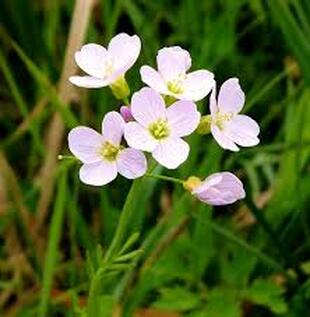|
Qualities of Lady's Smock
Soft curls of innocent love, Subtle blooms of a maiden’s heart. Pink and white flowers of gentle persuasion, Midst rough coarse grass and buttercup invasion. Crisp cold winds, flat wet meadows, Suffused with beauty, as she softly spreads, Fresh new excitement, Spring's quickening pulse, Tenacious young growth, love ever unfolding. J.Huet 2018 Common Name: Lady's smock Latin : Cardamine pratensis Family: Brassicaceae (Cruciferae) History and/or use: Good for coughs and digestion Widlife Value: Good food plants for the caterpillars of green veined white and orange tip butterflies. On the edge of an ancient woodland I used to visit in my teens was a brook and a wet meadow cheered by ragged robin, lady’s smock and a hedge of Blackthorn. It brought much joy to me and a reminder of the importance of our wetlands which we have drained in the pursuit of agriculture. Indeed a quarter of Britain once consisted of some type of wetland be it a bog, meadow, fen or marsh. Lady’s smock is a delicate looking yet hardy plant, a spring addition to wet areas. Its subtle white or mauve flowers and soft foliage warms the heart in April through to June. It may well be the time of year that it flowers that gives it the name of Cuckoo flower or the fact that it is home to the substance known as cuckoo-spit ( which is made from froghopper bug nymphs). Its spring blooms also give rise to associations with milkmaids, their smocks and to the Virgin Mary. Older spring traditions remind us to respect the lady of the land as picking the plant can lead to a snake bite and bringing it indoors can cause a lightning strike. Folk traditions are urging us to treat her bounty with respect as the snake is a sign of spring and the lightning a reminder of elemental power. Where the grass is damp and green, Where shallow streams are flowing, Where the cowslip buds are showing, I am seen. Dainty as a fairy’s frock, White or mauve, of elfin showing, ‘Tis the meadow-maiden growing- Lady’s-smock Cicely Mary Barker If you have any medical conditions please check with a medical herbalist first before taking any plant and only harvest it if you are 100% sure what it is! Lady's smock in medical literature, as in the writings of John Ray, is given a reputation for healing nervous afflictions as it was believed to ease hysteria due to its function as a powerful antispasmodic. Mistletoe is another plant said to have been used in this way. However we would expect more evidence of this use in folk traditions which tend to focus on its ability to help fevers such as in the Highlands and in Gloucestershire the plant was commonly used for headaches. The plant is rich in vitamin C which is probably why it has been used to ease scurvy and is a good tonic for coughs. Traditional uses also include breaking stones, restoring appetite, helping digestion and warming a cold and weak stomach. If you would like to support our work and go even more deeply into Nature Connection please become a member and have exclusive access to our online course.
0 Comments
Leave a Reply. |
Details
Poetry of flowersJoin me to explore the flora of the British Isles on this blog. My intention is to attempt to capture the unique quality and beauty of each species of flower, tree or shrub. For every species featured I will be growing many more wildflowers to celebrate the joy of their existence, their intrinsic conservation value and bewildering array of uses. For nearly 30 years I have noted, studied and explored wildflowers in the field much to the patience of the walker beside me. To share this passion is a heartfelt plea to respect, preserve and care for all British Wildflowers no matter how common they seem. Archives
February 2024
Categories |


 RSS Feed
RSS Feed
